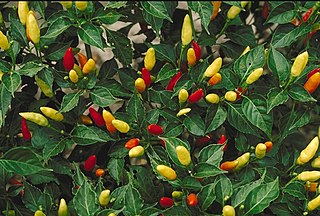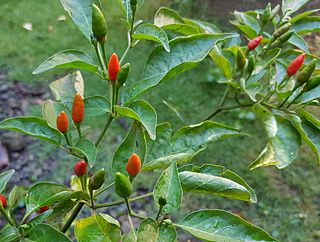
The Scoville scale is a measurement of the pungency of chili peppers, as recorded in Scoville Heat Units (SHU), based on the concentration of capsaicinoids, among which capsaicin is the predominant component. The scale is named after its creator, American pharmacist Wilbur Scoville, whose 1912 method is known as the Scoville organoleptic test. The Scoville organoleptic test is the most practical method for estimating SHU and is a subjective assessment derived from the capsaicinoid sensitivity by people experienced with eating hot chilis.

Capsaicin (8-methyl-N-vanillyl-6-nonenamide) is an active component of chili peppers, which are plants belonging to the genus Capsicum. It is a chemical irritant for mammals, including humans, and produces a sensation of burning in any tissue with which it comes into contact. Capsaicin and several related alkaloids are called capsaicinoids and are produced as secondary metabolites by chili peppers, probably as deterrents against certain mammals and fungi. Pure capsaicin is a hydrophobic, colorless, highly pungent, crystalline to waxy solid compound.

The bell pepper is the fruit of plants in the Grossum cultivar group of the species Capsicum annuum. Cultivars of the plant produce fruits in different colors, including red, yellow, orange, green, white, and purple. Bell peppers are sometimes grouped with less pungent pepper varieties as "sweet peppers". While they are fruits—botanically classified as berries—they are commonly used as a vegetable ingredient or side dish.

The chili pepper, from Nahuatl chīlli, is the berry-fruit of plants from the genus Capsicum which are members of the nightshade family, Solanaceae. Chili peppers are widely used in many cuisines as a spice to add pungent 'heat' to dishes. Capsaicin and related compounds known as capsaicinoids are the substances giving chili peppers their intensity when ingested or applied topically.

The jalapeño is a medium-sized chili pepper pod type cultivar of the species Capsicum annuum. A mature jalapeño chili is 5–10 cm (2–4 in) long and hangs down with a round, firm, smooth flesh of 25–38 mm wide. It can have a range of pungency, with Scoville heat units of 3,500 to 8,000. Commonly picked and consumed while still green, it is occasionally allowed to fully ripen and turn red, orange, or yellow. It is wider and generally milder than the similar Serrano pepper.

Capsicum annuum is a species of the plant genus Capsicum native to southern North America and northern South America. This species is the most common and extensively cultivated of the five domesticated capsicums. The species encompasses a wide variety of shapes and sizes of peppers, both mild and hot, such as bell peppers, jalapeños, New Mexico chile, and cayenne peppers. Cultivars descended from the wild American bird pepper are still found in warmer regions of the Americas. In the past, some woody forms of this species have been called C. frutescens, but the features that were used to distinguish those forms appear in many populations of C. annuum and are not consistently recognizable features in C. frutescens species.

Capsicum frutescens is a wild chili pepper having genetic proximity to the cultivated pepper Capsicum chinense native to the Amazon Basin. Pepper cultivars of C. frutescens can be annual or short-lived perennial plants. Flowers are white with a greenish white or greenish yellow corolla, and are either insect- or self-pollinated. The plants' berries typically grow erect; ellipsoid-conical to lanceoloid shaped. They are usually very small and pungent, growing 10–20 millimetres (0.39–0.79 in) long and 3–7 millimetres (0.12–0.28 in) in diameter. Fruit typically grows a pale yellow and matures to a bright red, but can also be other colors. C. frutescens has a smaller variety of shapes compared to other Capsicum species. C. frutescens has been bred to produce ornamental strains because of its large quantities of erect peppers growing in colorful ripening patterns.

Capsicum chinense, commonly known as a "habanero-type pepper", is a species of chili pepper native to the Americas. C. chinense varieties are well known for their unique flavors and many have exceptional heat. The hottest peppers in the world are members of this species, with Scoville Heat Unit scores of over 2 million. Some taxonomists consider them to be part of the species C. annuum, and they are a member of the C. annuum complex; however, C. chinense and C. annuum pepper plants can sometimes be distinguished by the number of flowers or fruit per node – two to five for C. chinense and one for C. annuum – though this method is not always correct. The two species can also hybridize and generate inter-specific hybrids. It is believed that C. frutescens is the ancestor to the C. chinense species.

The poblano is a mild chili pepper originating in the state of Puebla, Mexico. Dried, it is called ancho or chile ancho, from the Spanish word ancho ("wide"). Stuffed fresh and roasted it is popular in chiles rellenos poblanos.

Siling labuyo is a small chili pepper cultivar that developed in the Philippines after the Columbian Exchange. It belongs to the species Capsicum frutescens and is characterized by triangular fruits which grow pointing upwards. The fruits and leaves are used in traditional Philippine cuisine. The fruit is pungent, ranking at 80,000 to 100,000 heat units in the Scoville Scale.
Colletotrichum capsici is a species of fungus and plant pathogen which causes leaf blight on Chlorophytum borivilianum, basil, chickpea and pepper as well as dieback in pigeonpea and anthracnose in poinsettia.

Banganapalle mangoes is a mango variety produced in Banganapalle of Kurnool district in the Indian state of Andhra Pradesh. It alone occupies 70% percent of total mango cultivable area of the state and was first introduced by the Farmers of Banaganapalli. It was registered as one of the geographical indication from Andhra Pradesh on 3 May 2017, under horticultural products by Geographical Indication Registry. It is also grown in the other parts of India and Pakistan. The fruit is described as obliquely oval in shape, around 14 cm in length, with yellow flesh and a thin, smooth yellow skin. The flesh is of a firm, meaty texture and is sweet and lacks fibre. The cultivar is the most sought after in Andhra Pradesh. It is a mid-season variety that is good for canning. This cultivar is a source of vitamin A & C and is also called king of Mangoes.

The peter pepper, Capsicum annuum var. annuum, is an heirloom chili pepper that is best known for its unusual shape. It is a type of Capsicum annuum, though it is not officially recognized as a cultivar of the species. It occurs in red and yellow varieties. The pepper is considered very rare, and its origin is unknown.

The cascabel chili(little bell), also known as the rattle chili, is one of the Mirasol cultivars of the species Capsicum annuum. The 'rattle' and 'bell' designations describe the tendency of loose seeds to rattle inside a dried cascabel when shaken. Fresh cascabel, which is 2–3 cm in diameter, is also known by the alias bola chili or chile bola. The pigmentation of the fresh chilis blends from green to red; when dried, the color darkens.

Guntur chillies are a group of chilli cultivars from the Guntur and Prakasam districts of Andhra Pradesh, India. They are renowned globally and exported to Asia, Canada, and Europe. The Guntur district is the main producer and exporter of most varieties of chillies and chilli powder from India to regions such as Sri Lanka, Bangladesh, Middle East, South Korea, the UK, the US, and Latin America. Chillies have various colours and flavours because of the level of capsaicin in them. Guntur chillies form an important part of curries and various popular dishes of the state of Andhra Pradesh in India. The main trading place for the Guntur chilli is called Guntur Mirchi Yard, which is Asia's largest dried red chilli market. Market prices for the chillies are accessible on the National Agriculture Market or e-NAM.

The ghost pepper, also known as bhut jolokia, is an interspecific hybrid chili pepper cultivated in Northeast India. It is a hybrid of Capsicum chinense and Capsicum frutescens and is closely related to the Naga Morich.

Amaravati is the legislative capital and the de facto seat of government of the Indian state of Andhra Pradesh. The city is located on the banks of river Krishna in Guntur District. Built on allotted space on the southern banks of Krishna River in Guntur district selected close to the geographical center of the state.

Capsicum is a genus of flowering plants in the nightshade family Solanaceae, native to the Americas, cultivated worldwide for their chili pepper or bell pepper fruit.

The cayenne pepper is a type of Capsicum annuum. It is usually a moderately hot chili pepper used to flavor dishes. Cayenne peppers are a group of tapering, 10 to 25 cm long, generally skinny, mostly red-colored peppers, often with a curved tip and somewhat rippled skin, which hang from the bush as opposed to growing upright. Most varieties are generally rated at 30,000 to 50,000 Scoville units.
















